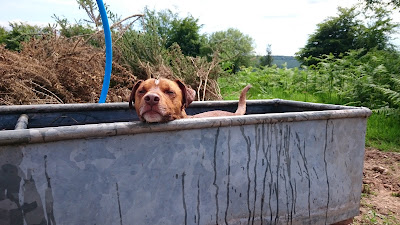We had the pleasure of meeting some wildlife and botany experts recently; Roger James and Martin Anthoney. Woody found them by the side of the road thinking they had broken down he stopped to help when they were actually very happy looking for wildlife in a neighboring field! Woody invited them up to our patch to get away from the weekend traffic and show them our little idyll.
Martin and Roger took some time talk to us and explored the land finding several species of moths, butterflies and meadow plants. It was a real treat to talk to people who really new their stuff and had such a passion for nature. I have been guessing and googling trying to read up bits here and there when I had time but it is so much more captivating to have enthusiastic people around to help identify the myriad of species we have come across.
 |
| Bedstraw and Milkwort (and a yellow strawberry type thing too!) |
It was really interesting that both gents identified the soil as "poor and acidic" by just looking at the plants around them. Very true as assessed by our soil sample analysis (maybe we should have got these guys in first!). As I had identified last summer many of the plants like the bed straw enjoy boggy and damp conditions however we are high up on free draining and rather stony ground that had stayed relatively firm through the winter (and don't we know it! we spent nearly every weekend up there!)
 |
| Trefoils |
Martin kindly emailed me his findings that evening and we hope to see them both again soon to watch them carry out a moth survey one evening.
*********
Woody and Lara
Thanks very much for your kind welcome today and letting us record butterflies. We found six species;
- Common Blue
- Green-veined White
- Large Skipper
- Peacock
- Small Copper
And three day-flying moths;
- Brown Silver-line
- Burnet Companion
- Silver-ground Carpet
With your permission we will certainly revisit every month or so to update the list and possibly run an MV knight at night to record moths. Some of the other reference sources we suggested might be useful;
Websites;
- The Wild Flowers of Britain and No than Europe - Richard Fitter, Alistair Fitter and Marjorie Blamey (Collins)
- Flora of Monmouthshire - Trevor Evans, ISBN 0 900278 49 8
- The Birds of Gwent - W A Venables et al (Christopher Helm London).
My colleague Roger James (Gwent Wildlife Trust president) is seeing what he can find out about the geology and history of the area and will contact you in due course.
I like your blog!
Many thanks and best wishes,
Martin Anthoney
************
Talking to the guys certainly made us realise how lucky we are to have access to such a precious area of habitat in an area largely consisting of managed agriculture and forestry.
 |
| Orchids in the gorse meadow |
It confirmed what we had already been thinking regarding our "Nature vs Nurture" thought process. We should try to preserve as much meadow as we can while creating the amenity areas, new planting and catering for the horses grazing requirements.
 |
| The muck heap! |
By adding lime and calcium to the top 2-3 acres we can ensure a better quality of grazing therefore limiting the horses grazing to the meadow area to the winter months only (if needed, we may just corral them and feed hay).
 |
| Natural gorse meadow (with the mown camping area in the foreground). |
The horses area has always been much more tame and mono-cultured than the other areas, where the heart of the meadow is incredibly diverse and any large changes in soil nutrience could change the culture forever.
 |
| Can you see him? |
We still have a lot to learn (as always!) and lots to think about before we make any long term changes. We hope to join one of the meadow walks run by Roger and will hopefully see the guys again for some moth identification over the summer.
 |
| What will this hatch into? |













